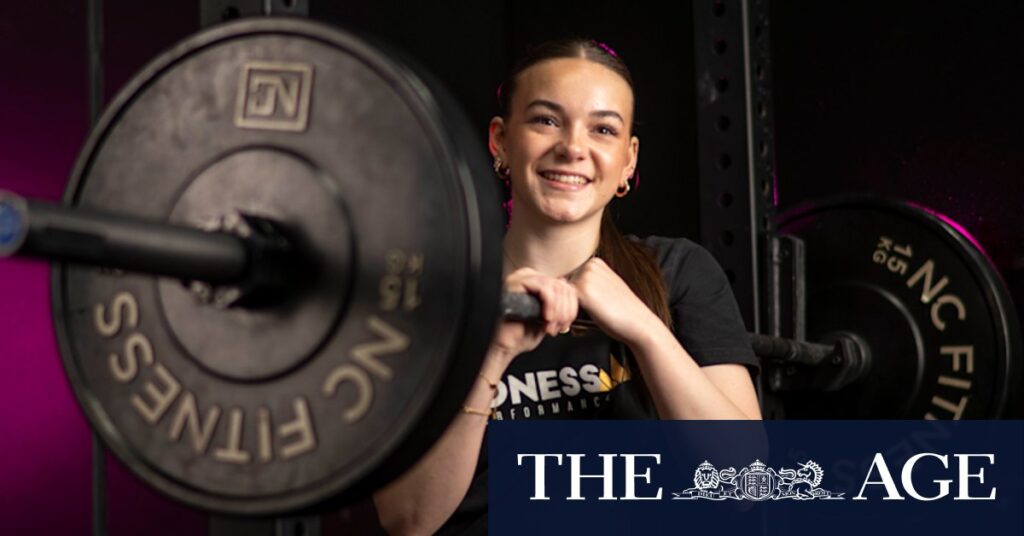
For many parents of teenagers, getting them out of bed on time for school is a daily challenge. However, for Melbourne teen Lara Jones, waking up before sunrise is just part of her routine, a way to engage in her passion: working out at the gym.
Before school, four days a week, the 16-year-old competitive powerlifter hits the gym at 6:30 a.m., undertaking a 55-minute session that combines programs with various stretches, activation exercises, weightlifting, and cardio tailored to specific areas of her body. “Over the past month, my training has shifted slightly as I’ve begun preparing for a Hyrox competition [an indoor fitness competition that combines running and various functional workout stations] in December,” she says. “Before starting this new phase, my focus was entirely on powerlifting, where I trained four strength-based sessions per week.”
The Journey to Strength
Jones first attended her local gym, Lioness Performance, at 13, inspired by the positive effect it had on her mother and her own desire to build strength. Over time, Jones became hooked on the process. “I fell in love with the process of lifting, setting goals, and pushing myself to improve, driving myself to new levels of strength, both physically and mentally,” she shares.
Large national surveys, including the AUSPLAY sport participation survey and the National Health Survey from the ABS, show that “fitness/gym” was the top-ranked activity for 15 to 17-year-olds in 2024, with a participation rate of about 30 percent. These figures have been consistent over the past decade, indicating a sustained interest in fitness among teenagers.
Guidelines and Safety Concerns
While there is no set legislation or minimum age for minors to access the gym in Australia, ages generally vary from 12 to 16 years nationwide. Dr. Jordan Smith from the School of Education at the University of Newcastle notes that most gyms in NSW follow guidelines from the 2004 NSW Department of Tourism, Sport, and Recreation’s ‘Kids in Gyms’ initiative. These recommendations include supervision for anyone under 16 and restrictions on resistance training for those aged 13 or under.
Specialist sports and exercise physiotherapist Dr. Loretta O’Sullivan-Pippia emphasizes the importance of adequate supervision and programs developed by qualified professionals to mitigate risks such as poor technique and inappropriate equipment use. “The negatives are usually due to a lack of adequate supervision and a program developed by appropriately qualified health and sports science professionals,” she says.
“One aspect that both my coaches and I have always made a top priority in my training is the importance of bracing …[which] is essential when lifting, especially when working with heavier weights like I do.” — Lara Jones
Social Media Influence
Aside from physical risks, Helen Bird, head of prevention at the Butterfly Foundation, highlights potential issues with body comparison and self-esteem. “The gym environment can invite comparison and self-objectification, leading people to feel that they aren’t fit, strong, lean, or muscular enough,” she explains.
Smith believes social media exacerbates these issues. “From a commonsense perspective, it’s hard to believe that social media is having no influence on teen gym usage,” he says. “Appearance matters a lot to young people, and there is no shortage of fitness influencers online that many young people will follow, and these did not exist prior to social media.”
Scrolling through TikTok or Instagram, it doesn’t take long to see videos of teens comparing biceps or posting workouts with hashtags such as #shredded, some of which have been viewed millions of times. Bird warns that focusing on weight can negatively impact a person’s relationship with exercise, self-esteem, body image, and mental health.
A Double-Edged Sword
Salim Sarkis, 17, from Sydney, who started going to the gym at age 15, describes social media as a “double-edged sword” for teens working out. “On one hand, it can promote extreme behavior like bulking up and wanting to be like Arnie [Arnold Schwarzenegger], but on the other hand, it can encourage self-improvement and make people happier and healthier,” he says.
Sarkis began by using hand weights in his grandparents’ backyard and teaching himself through YouTube tutorials. “At first, it sucked. I just thought, oh my gosh, it’s just painful. I get sweaty, I get uncomfortable, but then over time I started to see results, and I started to feel more confident.”
“You gain that extra confidence when you see the results on your body physically, but most importantly, the mental health aspects of working out, that’s something I really, really appreciate.” — Salim Sarkis
The Positive Impact of Fitness
Experts like O’Sullivan-Pippia, Bird, and Smith agree that exercising, when done appropriately and for the right reasons, is one of the best things for teenagers’ health and wellbeing, with a tremendous positive impact on mental health. But there’s another benefit that both Sarkis and Jones cherish: the community.
“I love being part of the gym community, connecting with people who share the same passion,” Jones says. “They have become like family.”
For confidential and free support for eating disorders, call the Butterfly National Helpline on 1800 ED HOPE (1800 33 4673) or visit www.butterfly.org.au to chat online or email.
Make the most of your health, relationships, fitness, and nutrition with our Live Well newsletter. Get it in your inbox every Monday.





